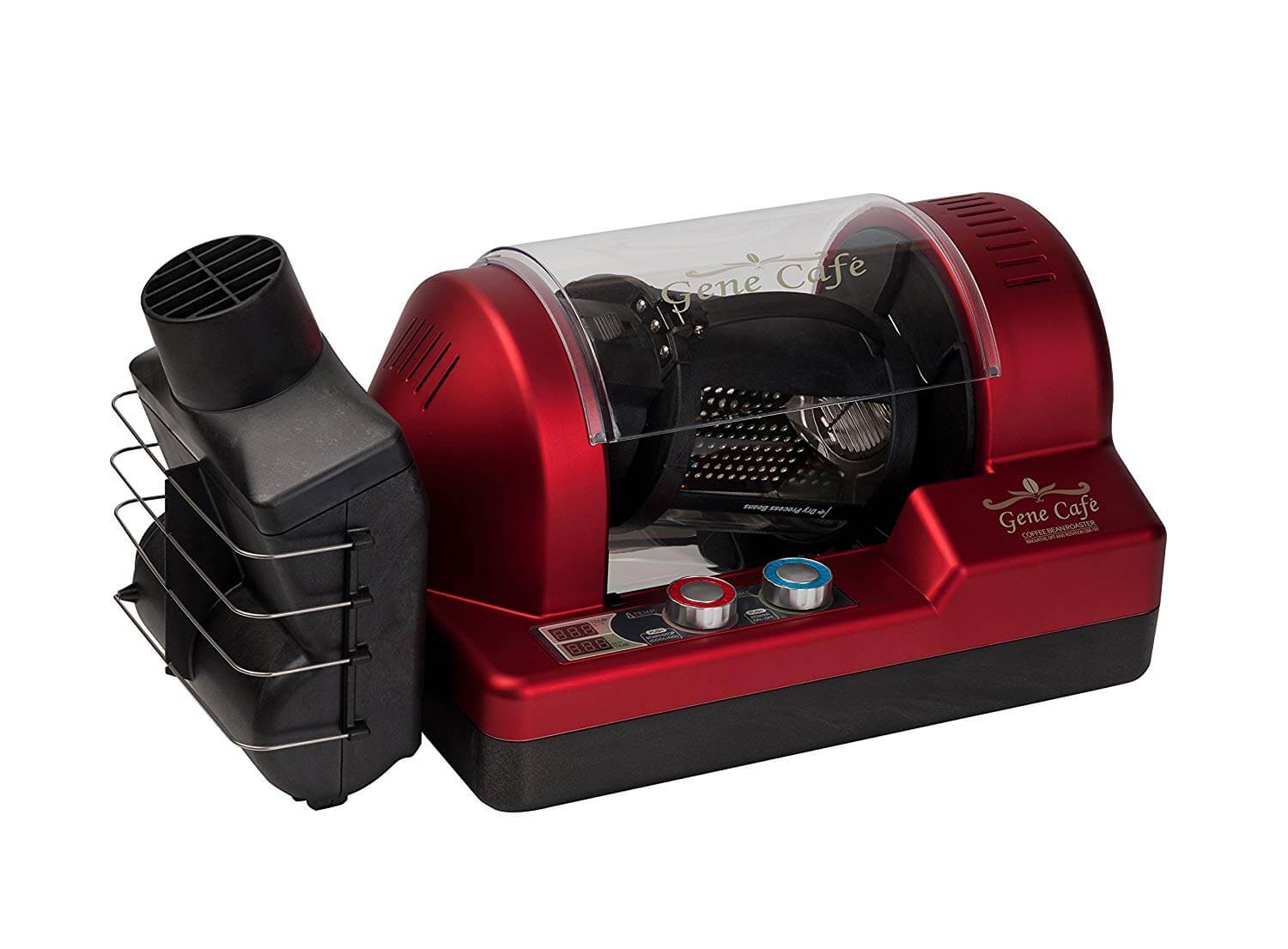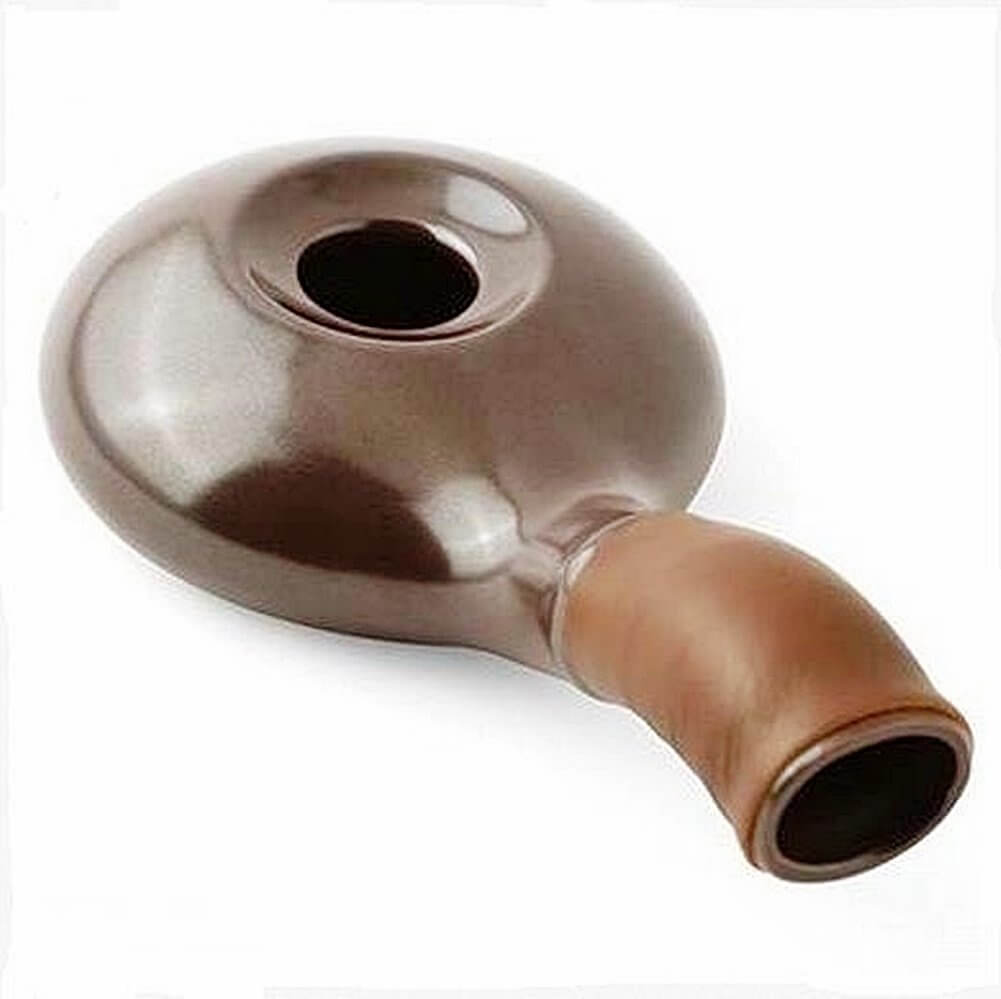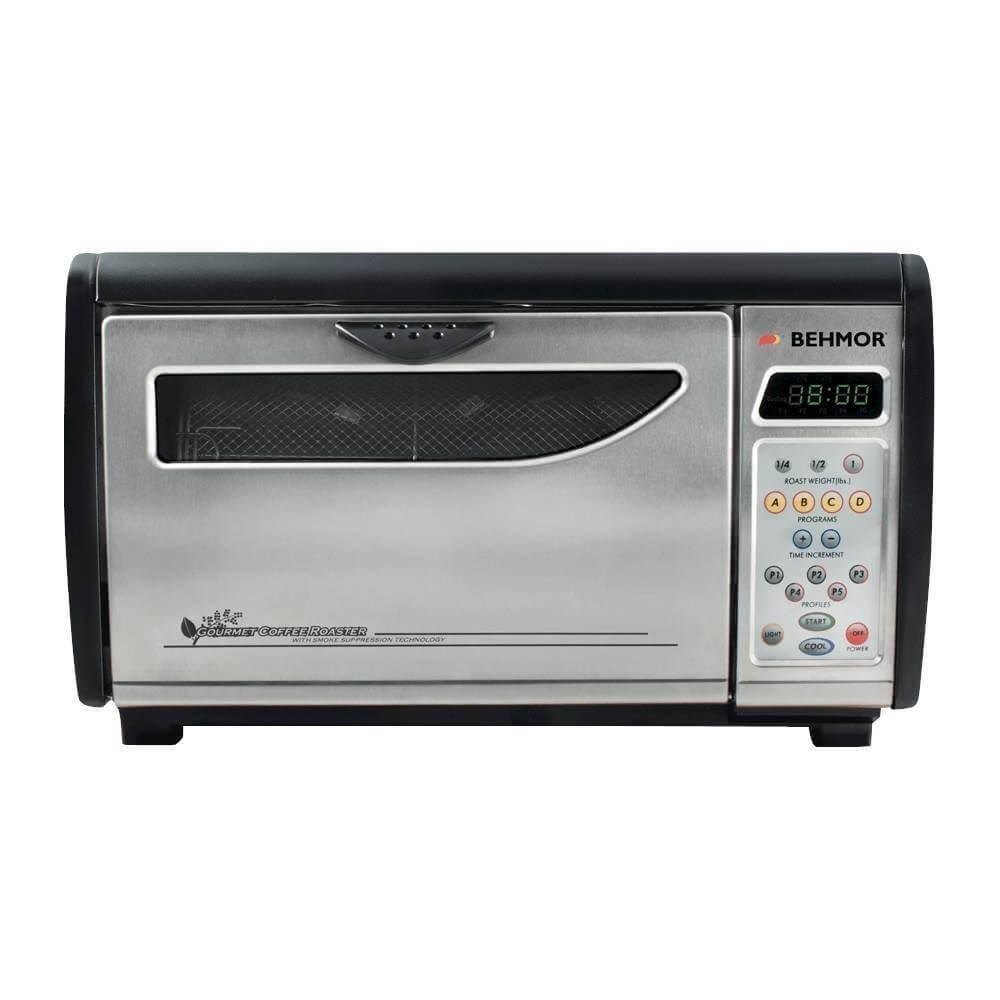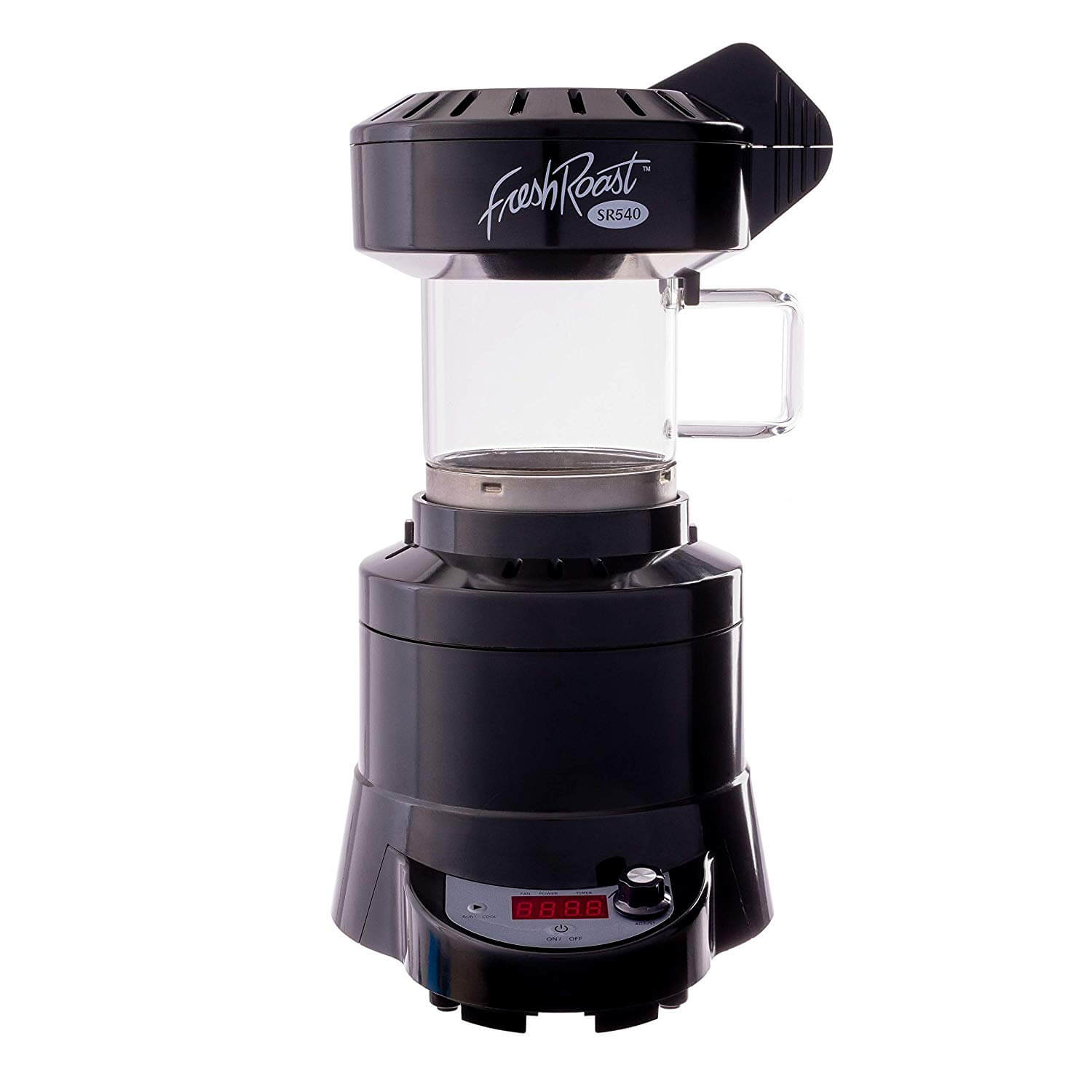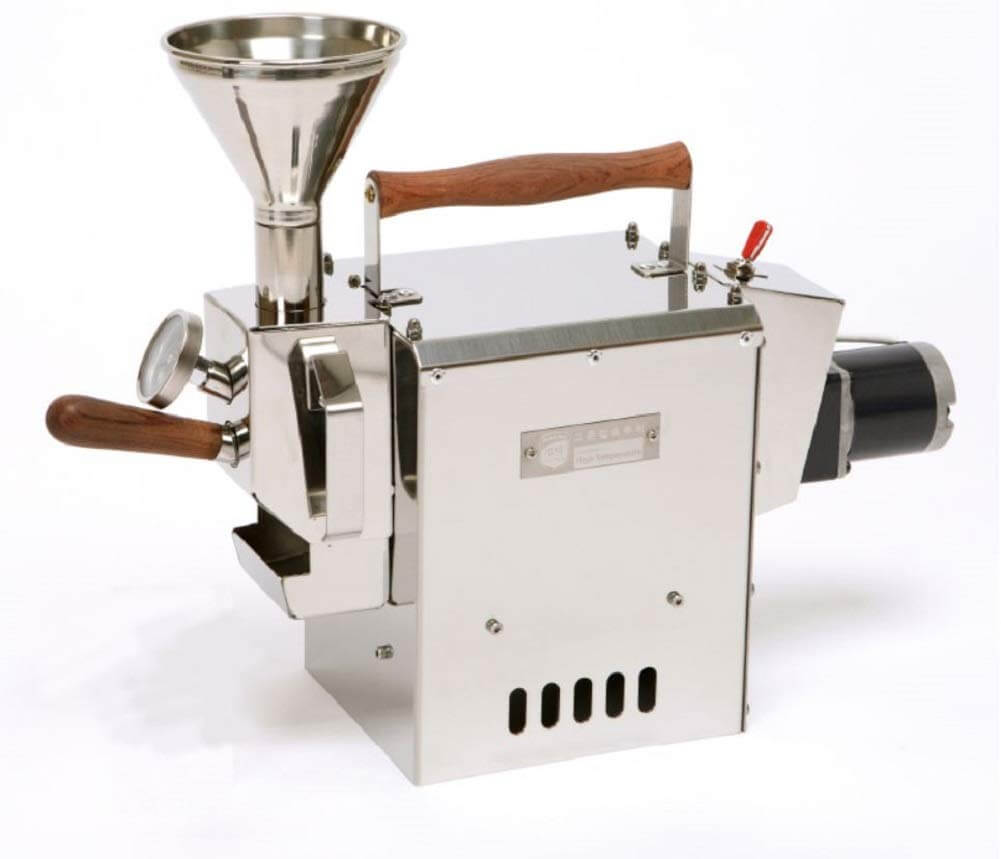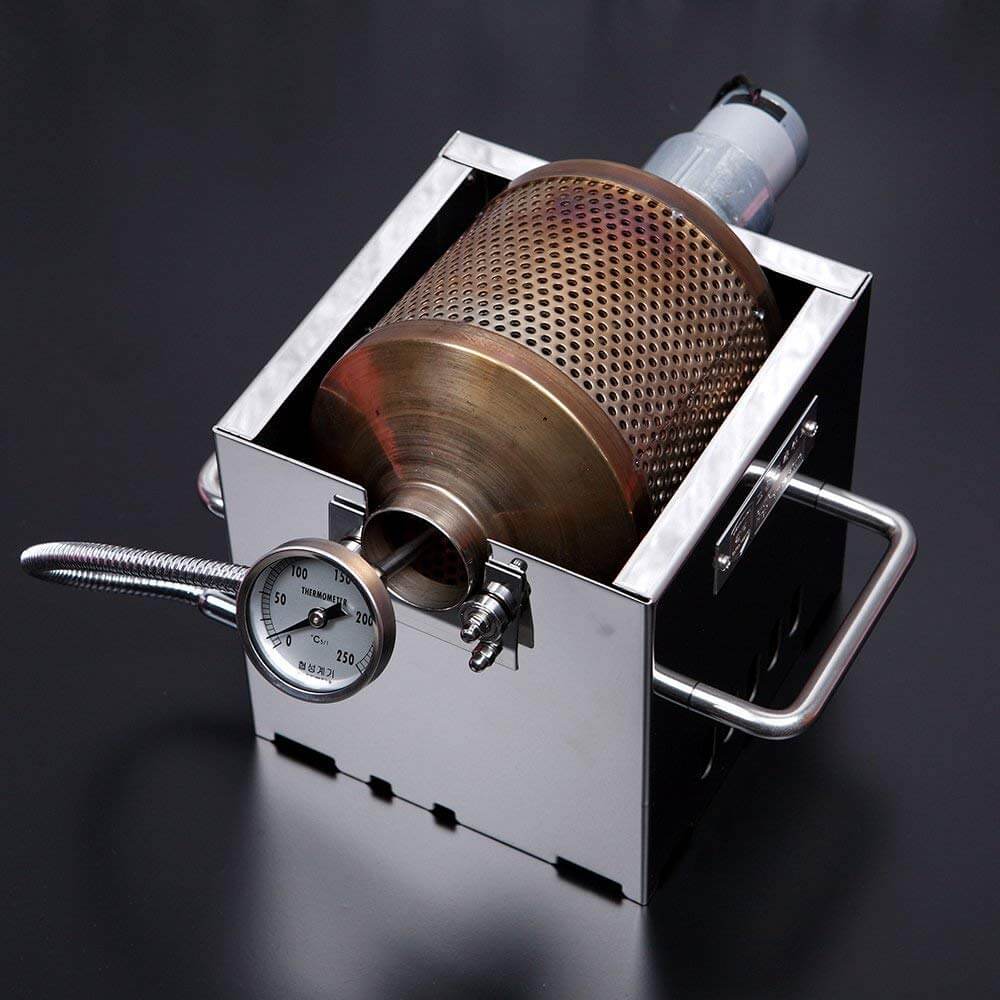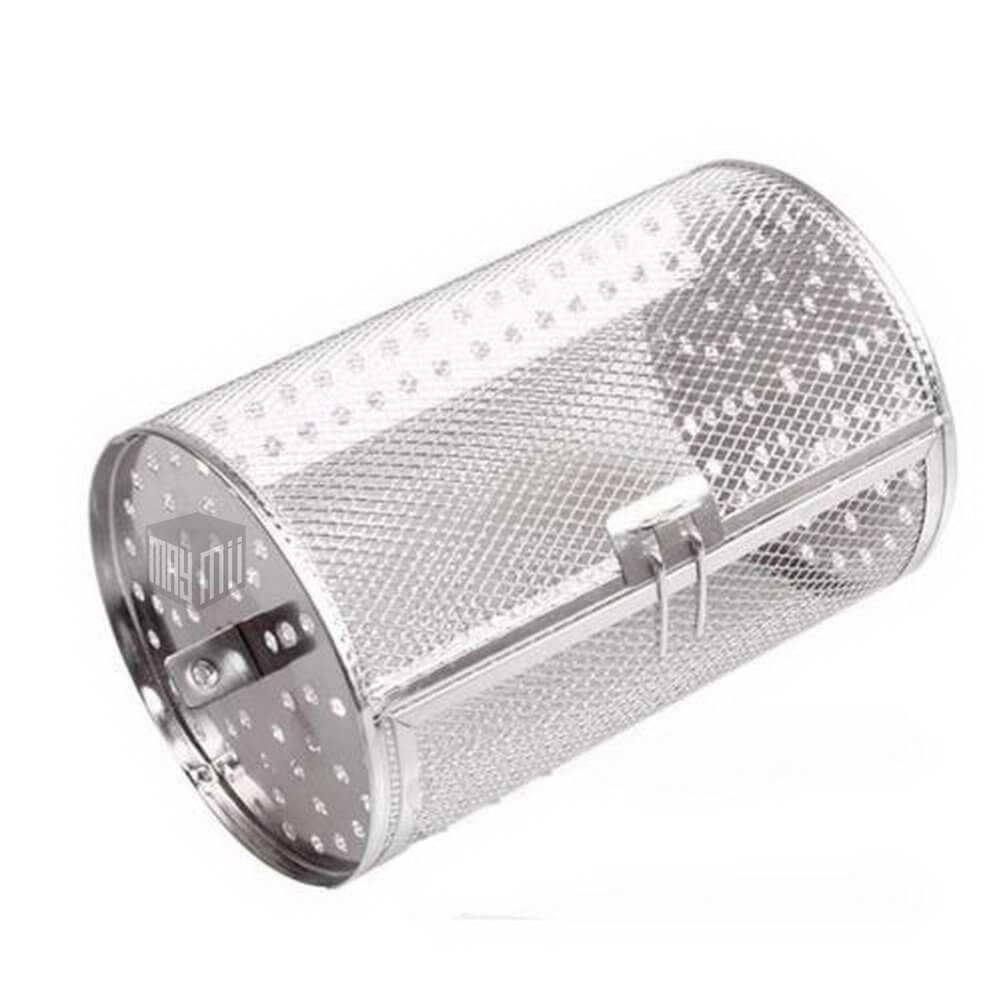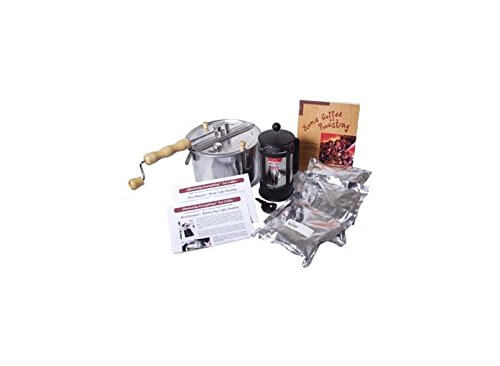If you are tired of tasteless coffees from your local coffee shop, then home roasting may just be the solution for you! Enjoying drinking coffee you know is freshly roasted by your own hand can really make the roasting effort worth it. Home roasting is also an ideal way to experiment with different origin beans and blends as well as roast types until you find the right beans for your morning cup!
In this review we take a look at home coffee roasters, both electric and stovetop. We also review some manual options that are not only more budget-friendly, but also ideal if you are new to home coffee roasting. We also offer some tips on what to think about when buying a roaster, as well as giving a quick rundown on home roasting and how to look after your beans once roasted.Best Pick
The Gene Cafe Home Coffee Roaster is our best pick of the home roasters with its 8 oz capacity and 15 minute roasting time.
Budget Pick
The Nuvo Eco ceramic coffee bean roaster is our budget and starter pick of the home roasters as it is ideal for roasting small quantities on the stovetop.
Quick Comparison: Top 8Best Home Coffee Roaster
1. Gene Cafe CBR-101 Home Coffee Roaster
Highlighted Features
-
An electric roaster than can be used on the countertop in a well-ventilated area
-
Has an off-axis vortex twisting roasting chamber which you can see into
-
There is a built-in chaff collector
-
Able to roast up to 8 oz of coffee in around 15 minutes
-
Has fully adjustable timer and temperature
The Gene Cafe Home Coffee Roaster (CBR-101) can roast around eight ounces of coffee uniformly. This roaster has a viewable vortex twisting chamber which is off-axis to allow the beans to be evenly distributed during roasting. Suitable for using on the countertop near open windows or a vent hood, this can roast in around 15 minutes and the temperature and timer are fully adjustable. It also has a built-in chaff collector.
You can struggle to hear the beans cracking with this roaster and the odd owner prefers to use this outdoors, or to attach a vent hose for maximum ventilation. The odd buyer has also experienced this overheating on occasion.Pros
-
Electric roaster
-
8 oz capacity
-
15 minutes roasting
-
Adjustable temperature
-
Built-in chaff collector
Cons
-
Can be difficult to hear beans cracking
-
You may want to use this outdoors, or vent it to outdoors
-
An odd owner has experienced this overheating during a roast
2. Nuvo Eco Ceramic Coffee Bean Roaster
Highlighted Features
-
A stovetop/open flame roaster made from ceramic
-
The inner is waffle-shaped to allow even bean roasting
-
Able to roast between 1 oz and 2.5 oz per roast
-
Has a cowhide covered handle to help protect against heat
The Nuvo Eco ceramic coffee bean roaster has a waffle-shaped inner to allow the beans to roast equally. This will need a gentle shake throughout roasting so that the beans roast equally. This also has a cowhide handle to help protect from heat, although gloves will still need to be worn while handling. This can roast between 1 oz and 2.5 oz of beans or around two to three cups of coffee - and the design will also allow you to hear cracking.
As a manual roaster, this will have to be used either outdoors or with all the kitchen windows open! It is suitable for using on any open flame, including a stove. Also suitable for electric cooktops, it cannot be used on induction. As this is ceramic, there can be a risk of it arriving damaged and the handle can be on the small side. This does not come with any instructions for how to use or clean it and, as a small manual roaster, it will not be ideal for all coffee drinkers.
Pros
-
Stovetop/open flame roaster
-
Ceramic
-
Can hear cracking
-
Waffle inner
-
Cowhide handle for heat protection
Cons
-
As a manual roaster this will need shaking throughout roasting
-
Not suitable for use on induction stovetops
-
Can only roast a small quantity of beans each time
-
Does not come with a user guide
3. Behmor 5400 Drum Coffee Roaster
Highlighted Features
-
A drum coffee roaster for roasting up to 1 lbs. of coffee
-
Thermostatically controlled quartz roasting elements and powered cooling cycle
-
Customizable roasting settings and a manual roasting option
-
The drum is lit and remains lit during roasting
-
The drum and chaff tray can be removed for easy cleaning
Able to roast up to one pound per batch, the Behmor 5400 drum coffee roaster has five customizable settings for roasting as well as a manual roasting option. This utilizes quart roasting elements that are thermostatically controlled and an efficient cooling cycle. This has a removable drum and chaff tray for easier cleaning.
This is designed to be used near a range hood or other type of ventilation, and it also suppresses smoke (patent pending). The inside of the roaster also remains lit during a roast cycle. This roaster is not suitable for roasting Italian, French, or darker beans.
As with any roaster, this roaster has a number of safety features and there can be a risk of the roaster going into a cooling mode during a roasting cycle. If this happens, then you either need to wait for the roaster to cool and then restart or finish the batch in the oven. Some owners have found that it will not easily roast darker than a medium, without the risk of over-roasting the beans. This also lacks an audible alarm for when the safety cooling starts, or indeed when the program finishes. The display can also be difficult to read.Pros
-
Electric roaster
-
1 lbs. capacity
-
Smoke suppressor
-
Customizable settings
-
Removable chaff tray
-
Drum light
Cons
-
Roaster can go into cooling mode during a roast cycle
-
May not always be easy to roast darker than a medium
-
No audible alarm
-
The display is not always easy to read
4. Fresh Roast SR540
Highlighted Features
-
An electric roaster that can roast 4 oz in around 10 minutes
-
Using convection heat which moves the beans around for even roasting
-
Has nine levels of heat and fan settings as well as a cooling option
-
Real-time temperature display showing air temperature in the roaster
-
The chaff collector is integrated
Able to roast four ounces of beans, the Fresh Roast SR540 has nine levels of heat and fan settings and a real-time temperature display. Roast in around 10 minutes, this is a compact and convection-style roaster that allows the beans to be moved around during roasting for a uniform roast. Once the roasting is completed, you can turn on the fan to cool down the beans faster. This does not have an smoke suppression, so it will need to used outdoors or in a very well-ventilated area.
This also has an integrated chaff collector. Although it does have a temperature display, this shows the temperature of the air entering the roaster rather than the actual temperature of the beans; making it more difficult to temperature optimize your roasting. The chaff collector may not always work so well, so you may need to manually remove the rest of the chaff from your roasted beans.Pros
-
Electric roaster
-
Compact style
-
Nine settings
-
10 minute roast
-
4 oz capacity
Cons
-
This roaster does not have a smoke suppressor
-
Does not give temperature of beans for easy roast monitoring
-
The chaff collector will not always remove all of the chaff
5. KALDI WIDE size Home Coffee Roaster
Highlighted Features
-
A stovetop/outdoor burner coffee roaster which also requires an electrical supply for rotating the drum
-
Able to roast up to 10.5 oz of beans
-
Comes with a thermometer, hopper and chaff holder
-
Made from stainless steel this can be partially dismantled for deep cleaning
Able to roast up to 10.5 oz of coffee, the KALDI coffee roaster is a stovetop (or outdoor burner) roaster which includes a hopper, thermometer and chaff holder. This also requires connecting to a power outlet to power the drum rotation. Manufactured from stainless steel, this can also be partially dismantled for occasional deep cleaning. The odd buyer has found that it will work better if beans are fed into it slowly rather than poured in all at once and the bearings can be prone to seizing occasionally.
Pros
-
Stovetop roaster
-
Outlet powered drum
-
10.5 oz capacity
-
Comes with thermometer
-
Chaff holder
Cons
-
Can work better if beans are fed into it slowly rather than poured in
-
There is a risk of the bearings seizing occasionally
6. KALDI Mini Coffee Roaster
Highlighted Features
-
A stovetop roaster with an electrically powered rotating drum
-
Has a capacity of between 7 oz and 8.8 oz of beans
-
Also includes a thermometer for temperature monitoring
The KALDI mini coffee roaster is a stovetop roaster able to roast between 7 oz and 8.8 oz of coffee. This also requires an electric source to power the rotating drum and it includes a thermometer. The odd buyer has received this roaster without a power converter for the US and it is suggested that you only roast 8 oz a time to reduce the risk of beans coming out of the other end during roasting.
Pros
-
Stovetop roaster
-
Drum electrically powered
-
8.8 oz capacity
-
Thermometer
Cons
-
The odd buyer has received this without a power convertor
-
Some owners suggest you roast 8 oz maximum to stop beans coming out the other end
7. MAYMII Coffee Roaster Drum
Highlighted Features
-
A multipurpose coffee roaster, peanut and rotisserie drum
-
Can be used in a toaster oven or on an outdoor grill
-
Made from stainless steel this has a center rod hole of 0.24" (6mm)
-
Has an overall capacity of 32 oz; but 8 oz of coffee beans is probably ample
Made from stainless steel, the MAYMII coffee roaster drum can also be used for peanuts and as a rotisserie drum on your outdoor grill or in a toaster oven. This drum measures 5" by 5" by 7" with a center rod hole of 0.24" (6mm) and the holes are small enough to prevent coffee beans from falling through.
Although the maximum capacity of this drum is 32 oz, for coffee beans; probably a quarter or so of this is enough to allow them to roast evenly. The odd buyer has been disappointed in the quality of this, and as a small drum is not suitable for roasting larger quantities of beans at any one time.Pros
-
Multipurpose roaster drum
-
Use on grill or in toaster oven
-
Stainless steel
-
Measures 5" by 5" by 7"
Cons
-
Some owners have been disappointed in its quality
-
Can only hold a fraction of its overall capacity when roasting coffee beans
8. Whirley-Pop Coffee Roasting Kit
Highlighted Features
-
A complete coffee roasting kit including a modified stovetop Whirley-Pop
-
Has a thermometer for better roasting
-
Also includes a tutorial, Bodum eight cup French Press and a home roasting coffee book
-
Comes with 3 lbs. of green beans from different origins
A complete kit for roasting, the Whirley-Pop coffee roasting kit includes a stovetop Whirley-Pop which has been modified to hold a thermometer for better roasting results. This roasting kit also includes a tutorial, a book on home coffee roasting, a Bodum eight cup French Press and three pounds of different origin green coffee beans.
As a manual coffee roaster, you will have to stand over the stovetop while the coffee is roasting and of course, if you need to stop cranking the Whirley-Pop, there is a good chance that you will burn your beans!Pros
-
Complete roasting kit
-
Stovetop roaster
-
Modified Whirley-Pop
-
Includes thermometer
-
Also includes green beans and French Press
Cons
-
You will need to stand over the stovetop when using this roaster
-
This also requires hand cranking constantly to prevent the beans from burning
Things to Consider Before Buying A Home Coffee Roaster
There are many chemical reactions occurring when coffee is roasted and even if you roast two batches of the same beans in the same machine on the same day, there can still be significant taste and aroma differences!
The roast profile is the term given to the process of converting green beans into roast beans and it is this that specialist coffee roasters modify and adjust to get the best roasts that they can. When you home roast, you can also develop your roast profile, although not all types of home roasters will give the same level of control over roasting as others.
Bespoke electric coffee roasters usually have more user control and use electrical means to turn the beans for even roasting. Some stovetop models will also have rotation systems while more traditional stovetop or oven roasters (or popcorn makers) will need you to regularly shake or crank the maker to ensure the beans roast uniformly. Stovetop roasters can also offer more precise control over temperature; especially when using gas.
Home roasting coffee can produce a lot of smoke and fumes. If you roast indoors then it should be under or near a vent hood or open windows. If you have the space, then roasting in the yard or porch will keep smoke out of your home. Some roasters can also be vented outdoors to keep the smoke and fumes down and even if using an electrical roaster with an auto-shutoff, you should always stay close by and monitor the roaster as once the second crack has happened, the beans will soon start to burn.
Green beans can be sourced from local coffee places that roast their own beans, or otherwise can be bought online. Although beans increase in size during roasting, they lose mass, so to obtain one pound of roast coffee beans you will need to roast two pounds of green beans.
When choosing green beans, consider what regions you enjoy coffee from, whether there are any specific varieties of bean you like or even how the green beans have been processed. Some beans will only suit a light roast to bring out their bright flavors while other beans will have optimum flavor when darker roasted.
Basics of Coffee Roasting
Green coffee beans can range in color from gray to green and these start to fade as the chlorophyll in the beans break down. As green coffee is heated, the Maillard reaction occurs, in which the sugars and amino acids in the beans react and interact which causes the formation of both flavor compounds, and melanoidins the compounds that give coffee its brown color.
Caramelization of sugars also occurs during the Maillard reaction, and as the main sugar in green coffee is sucrose - which does not take part in the Maillard reaction - the sucrose caramelizes which also gives more brown compounds. All of this means that as the beans roast, they turn yellow, darken to tan and then brown.
If the beans continue to roast, then the color will move towards black as the sugars and cellulose break down into carbon.
Coffee beans also lose around 10% to 20% of their mass during roasting as water leaves the beans in the form of vapor alongside volatile compounds, carbon dioxide and free nitrogen. While losing mass, they may also double in volume as they puff when the water vapor is released.
The indicator of this happening is known as the first crack. Similar to the sound of corn popping, the beans fracture as the cellulose of the beans can no longer hold the water vapor inside them. This allows the beans to then puff up as the steam escapes. After this first crack, the beans are City Roast, or the minimum acceptable roast level for most of our tastes.
As the coffee roasts further, more sugar caramelizes and oils migrate and at this point, the beans have reached a City Plus Roast. Moving towards the second crack; a Full City Roast is when the beans are on verge of their second crack. Occurring at around 440F, the second crack occurs because the cellulose of the beans is now weakened and starting to break apart because of the constant heat.
Carbon dioxide and oils are now released from the coffee beans which have had their cell walls broken. Sounding like more of a crackle than a pop, the second crack indicates that the beans are now a Full City Plus Roast which will offer flavor with more layers of intensity.
If you continue to roast after this, then a Dark Roast (or French Roast) will occur. At this point, sugars are burning as much as they can without ruining the flavor of the coffee and the smoke has become pungent. This is the final roasting point at which the beans can reach and still maintain good flavor. If roasting continues past this point, then the beans will burn!
Roasts in More Detail
The type of roast is often distinguished by the internal temperature of the beans when they are removed from the roaster. A light roast, Half City, Light City or Cinnamon Roast falls around the first crack at around 356F to 401F. Light roast beans will still be quite dense, and the surface of the beans will still be dry. A typical light brew has light body and more acidity.
For a medium roast, beans need to roast at around 410 to 428F, or some will aim for between first and second crack. Medium roast will give mid-acidity and fuller body and the surface of the beans will still be quite dry.
The Full City and Full City Plus are medium-dark roasts, at a temperature of between 437F and 446F. Some oil will also be starting to appear on the beans, especially as they reach the second crack. The body of a medium roast is heavier and spicier, and the roast flavors will start to feature more strongly against the brighter flavors.
A dark roast is much more difficult to achieve at home as the temperature needs to reach around 464 F, but no higher than 482 F, and home roasters will rarely allow you to roast up to this temperature it is more likely that safety mechanisms will kick in and start to cool the roaster down. This is also the point at which the beans can quickly move from roasted to toasted! Dark roasts such as Espresso, French and Italian roasts have low acidity and an oily surface.
Temperature Monitoring During Roasting
Although a number of home coffee roasters include a thermometer, it is important to monitor and track temperature during roasting. If you are using a stovetop roaster, then insert a thermometer so that the probe rests in the beans during roasting. Make a note of the temperature at the first crack, and if roasting darker, the second crack also. You can then refer back to these when making your tasting notes or refining your roasting process.
After Roasting
If your home roaster does not have a cooling feature, then beans should be immediately removed from the roaster and placed in a ceramic bowl to allow the heat to dissipate from them. If beans are left hot after roasting, they will continue to roast.
You will also need to remove the chaff (dried coffee bean skin) if your roaster does not remove it during roasting. The easiest way to do this is by carefully moving the hot beans between two colanders. A small amount of chaff left on the beans will rarely impact on the taste of your brew.
You can cool roasted beans by laying them out on a cookie sheet for a few hours. If they are not being used immediately, then allow them to cool for 12 or so hours; especially if they are a darker roast. This is to allow the excess gasses to escape from the beans. You can then move them to an airtight container, leaving the lid slightly loose for another day before fastening tightly. If all the gasses have not escaped before you fasten the lid, there is a risk of it blowing off as further carbon dioxide is released from the beans!
Once coffee has been roasted it starts to lose some of its aroma and flavor within a week or so of having been roasted, so to keep them at their best, use them within five days of roasting.
Conclusion
We hope you have enjoyed reading about home roasting and what the difference is between different types of roasts, as well as why it is so important to listen for coffee beans cracking! We have also looked at the pros and cons of stovetop and electrical home coffee roasters as well as a few of the manual options for home roasting.
If you are a seasoned roaster or just new to it all, we do hope you have found our reviews of the best home coffee roaster have helped you to choose the right roaster for your budget and your home.The post Best Home Coffee Roaster for A Full City Roast appeared first on Food Shark Marfa .


